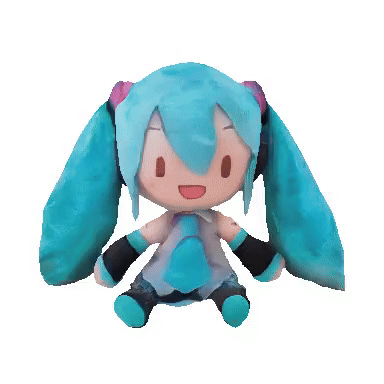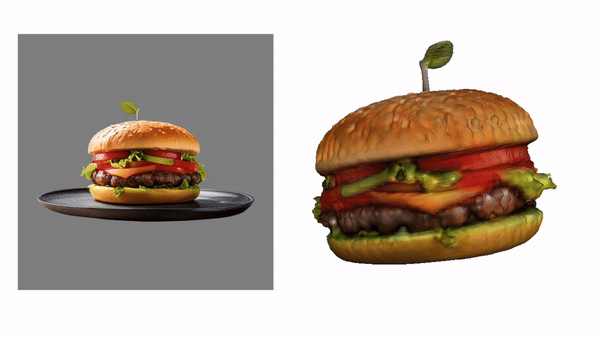instantmesh
Maintainer: camenduru

35

| Property | Value |
|---|---|
| Run this model | Run on Replicate |
| API spec | View on Replicate |
| Github link | View on Github |
| Paper link | View on Arxiv |
Create account to get full access
Model overview
InstantMesh is an efficient 3D mesh generation model that can create realistic 3D models from a single input image. Developed by researchers at Tencent ARC, InstantMesh leverages sparse-view large reconstruction models to rapidly generate 3D meshes without requiring multiple input views. This sets it apart from similar models like real-esrgan, instant-id, idm-vton, and face-to-many, which focus on different 3D reconstruction and generation tasks.
Model inputs and outputs
InstantMesh takes a single input image and generates a 3D mesh model. The model can also optionally export a texture map and video of the generated mesh.
Inputs
- Image Path: The input image to use for 3D mesh generation
- Seed: A random seed value to use for the mesh generation process
- Remove Background: A boolean flag to remove the background from the input image
- Export Texmap: A boolean flag to export a texture map along with the 3D mesh
- Export Video: A boolean flag to export a video of the generated 3D mesh
Outputs
- Array of URIs: The generated 3D mesh models and optional texture map and video
Capabilities
InstantMesh can efficiently generate high-quality 3D mesh models from a single input image, without requiring multiple views or a complex reconstruction pipeline. This makes it a powerful tool for rapid 3D content creation in a variety of applications, from game development to product visualization.
What can I use it for?
The InstantMesh model can be used to quickly create 3D assets for a wide range of applications, such as:
- Game development: Generate 3D models of characters, environments, and props to use in game engines.
- Product visualization: Create 3D models of products for e-commerce, marketing, or design purposes.
- Architectural visualization: Generate 3D models of buildings, landscapes, and interiors for design and planning.
- Visual effects: Use the generated 3D meshes as a starting point for further modeling, texturing, and animation.
The model's efficient and robust reconstruction capabilities make it a valuable tool for anyone working with 3D content, especially in fields that require rapid prototyping or content creation.
Things to try
One interesting aspect of InstantMesh is its ability to remove the background from the input image and generate a 3D mesh that focuses solely on the subject. This can be a useful feature for creating 3D assets that can be easily composited into different environments or scenes. You could try experimenting with different input images, varying the background removal settings, and observing how the generated 3D meshes change accordingly.
Another interesting aspect is the option to export a texture map along with the 3D mesh. This allows you to further customize and refine the appearance of the generated model, using tools like 3D modeling software or game engines. You could try experimenting with different texture mapping settings and see how the final 3D models look with different surface materials and details.
This summary was produced with help from an AI and may contain inaccuracies - check out the links to read the original source documents!
Related Models

tripo-sr

4
tripo-sr is an AI model developed by Replicate that enables fast 3D object reconstruction from a single image. It is related to models like InstantMesh, Champ, Arc2Face, GFPGAN, and Real-ESRGAN, which also focus on 3D reconstruction, image synthesis, and enhancement. Model inputs and outputs The tripo-sr model takes a single input image, a foreground ratio, and a boolean flag to remove the background. It outputs a reconstructed 3D model in the form of a URI. Inputs Image Path**: The input image to reconstruct in 3D Foreground Ratio**: A value between 0.5 and 1.0 controlling the percentage of the image that is considered foreground Do Remove Background**: A boolean flag to indicate whether the background should be removed Outputs Output**: A URI pointing to the reconstructed 3D model Capabilities tripo-sr is capable of generating high-quality 3D reconstructions from a single input image. It can handle a variety of object types and scenes, making it a flexible tool for 3D modeling and content creation. What can I use it for? The tripo-sr model could be used for a variety of applications, such as 3D asset generation for video games, virtual reality experiences, or product visualization. Its ability to quickly reconstruct 3D models from 2D images could also be useful for 3D scanning, prototyping, and reverse engineering tasks. Things to try Experiment with the foreground ratio and background removal options to see how they impact the quality and usefulness of the reconstructed 3D models. You could also try using tripo-sr in conjunction with other AI models like GFPGAN or Real-ESRGAN to enhance the input images and further improve the 3D reconstruction results.
Updated Invalid Date

lgm

3
The lgm model is a Large Multi-View Gaussian Model for High-Resolution 3D Content Creation developed by camenduru. It is similar to other 3D content generation models like ml-mgie, instantmesh, and champ. These models aim to generate high-quality 3D content from text or image prompts. Model inputs and outputs The lgm model takes a text prompt, an input image, and a seed value as inputs. The text prompt is used to guide the generation of the 3D content, while the input image and seed value provide additional control over the output. Inputs Prompt**: A text prompt describing the desired 3D content Input Image**: An optional input image to guide the generation Seed**: An integer value to control the randomness of the output Outputs Output**: An array of URLs pointing to the generated 3D content Capabilities The lgm model can generate high-resolution 3D content from text prompts, with the ability to incorporate input images to guide the generation process. It is capable of producing diverse and detailed 3D models, making it a useful tool for 3D content creation workflows. What can I use it for? The lgm model can be utilized for a variety of 3D content creation tasks, such as generating 3D models for virtual environments, game assets, or architectural visualizations. By leveraging the text-to-3D capabilities of the model, users can quickly and easily create 3D content without the need for extensive 3D modeling expertise. Additionally, the ability to incorporate input images can be useful for tasks like 3D reconstruction or scene generation. Things to try Experiment with different text prompts to see the range of 3D content the lgm model can generate. Try incorporating various input images to guide the generation process and observe how the output changes. Additionally, explore the impact of adjusting the seed value to generate diverse variations of the same 3D content.
Updated Invalid Date

ml-mgie

5
ml-mgie is a model developed by Replicate's Camenduru that aims to provide guidance for instruction-based image editing using multimodal large language models. This model can be seen as an extension of similar efforts like llava-13b and champ, which also explore the intersection of language and visual AI. The model's capabilities include making targeted edits to images based on natural language instructions. Model inputs and outputs ml-mgie takes in an input image and a text prompt, and generates an edited image along with a textual description of the changes made. The input image can be any valid image, and the text prompt should describe the desired edits in natural language. Inputs Input Image**: The image to be edited Prompt**: A natural language description of the desired edits Outputs Edited Image**: The resulting image after applying the specified edits Text**: A textual description of the edits made to the input image Capabilities ml-mgie demonstrates the ability to make targeted visual edits to images based on natural language instructions. This includes changes to the color, composition, or other visual aspects of the image. The model can be used to enhance or modify existing images in creative ways. What can I use it for? ml-mgie could be used in various creative and professional applications, such as photo editing, graphic design, and even product visualization. By allowing users to describe their desired edits in natural language, the model can streamline the image editing process and make it more accessible to a wider audience. Additionally, the model's capabilities could potentially be leveraged for tasks like virtual prototyping or product customization. Things to try One interesting thing to try with ml-mgie is providing more detailed or nuanced prompts to see how the model responds. For example, you could experiment with prompts that include specific color references, spatial relationships, or other visual characteristics to see how the model interprets and applies those edits. Additionally, you could try providing the model with a series of prompts to see if it can maintain coherence and consistency across multiple editing steps.
Updated Invalid Date
🤖
InstantMesh

107
InstantMesh is a feed-forward framework for efficient 3D mesh generation from a single image. It leverages the strengths of a multiview diffusion model and a sparse-view reconstruction model based on the LRM architecture to create diverse 3D assets quickly. By integrating a differentiable iso-surface extraction module, InstantMesh can directly optimize on the mesh representation to enhance training efficiency and exploit more geometric supervisions. Compared to other image-to-3D baselines, InstantMesh demonstrates state-of-the-art generation quality and significant training scalability. It can generate 3D meshes within 10 seconds, making it a powerful tool for 3D content creation. The model is developed by TencentARC, a leading AI research group. Model Inputs and Outputs Inputs Single image Outputs 3D mesh representation of the input image Capabilities InstantMesh can generate high-quality 3D meshes from a single image, outperforming other latest image-to-3D baselines both qualitatively and quantitatively. By leveraging efficient model architectures and optimization techniques, it can create diverse 3D assets within a short time, empowering both researchers and content creators. What can I use it for? InstantMesh can be a valuable tool for a variety of 3D content creation applications, such as game development, virtual reality, and visual effects. Its ability to generate 3D meshes from a single image can streamline the 3D modeling process and enable rapid prototyping. Content creators can use InstantMesh to quickly generate 3D assets for their projects, while researchers can explore its potential in areas like 3D scene understanding and reconstruction. Things to try Users can experiment with InstantMesh to generate 3D meshes from diverse input images and explore the model's versatility. Additionally, researchers can investigate ways to further improve the generation quality and efficiency of the model, potentially by incorporating additional geometric supervision or exploring alternative model architectures.
Updated Invalid Date